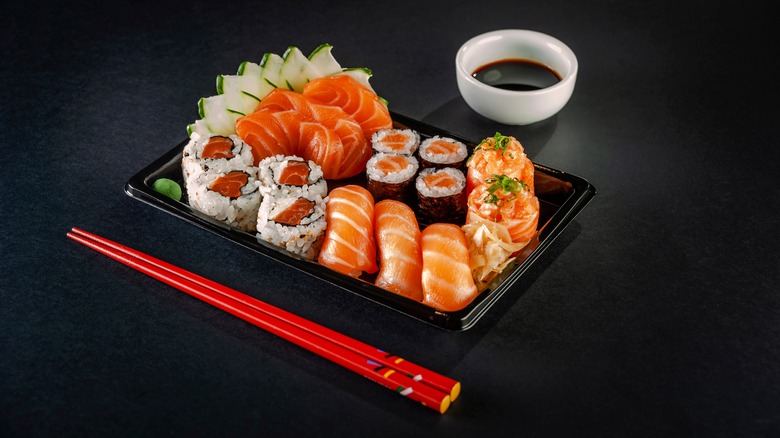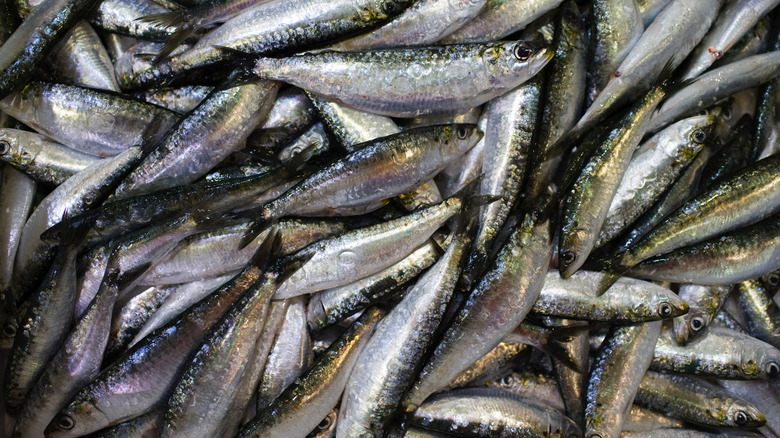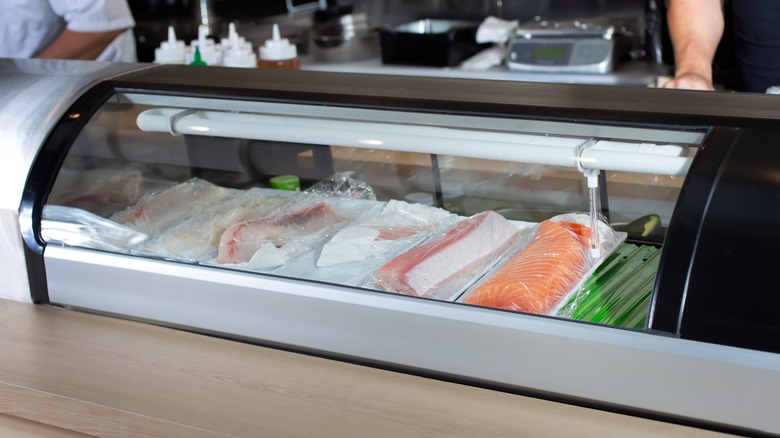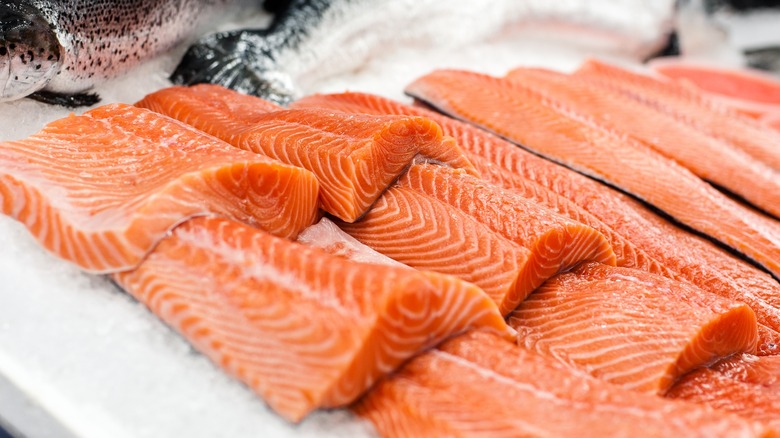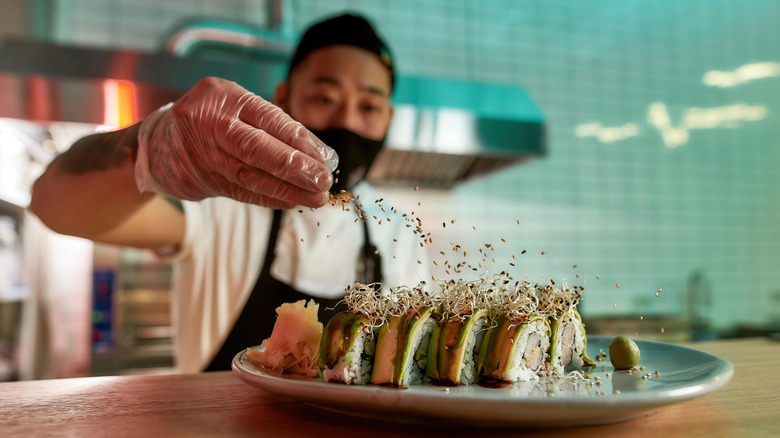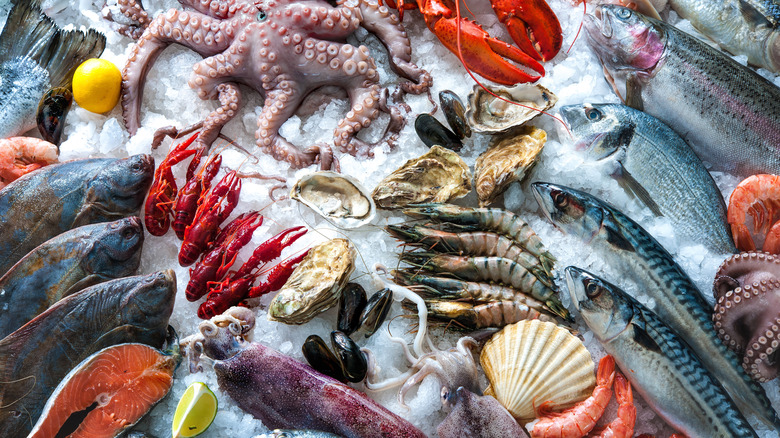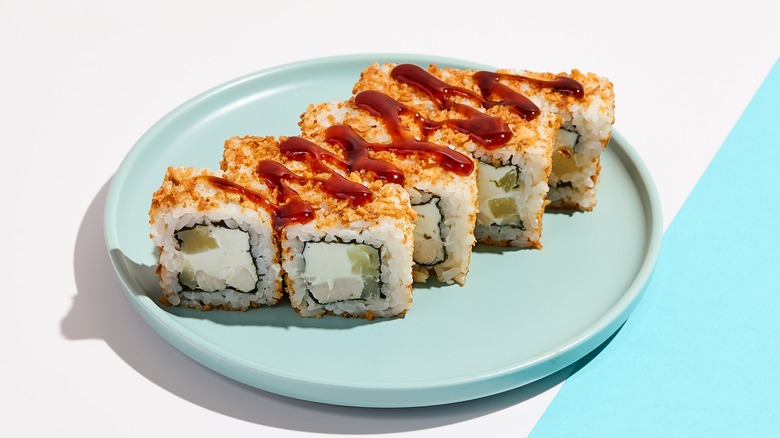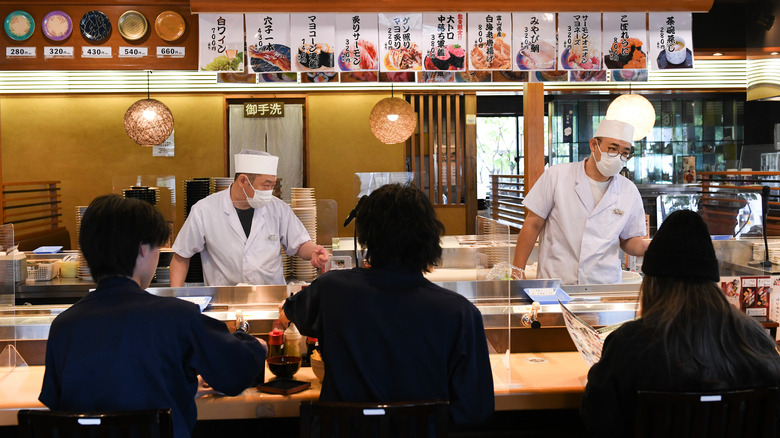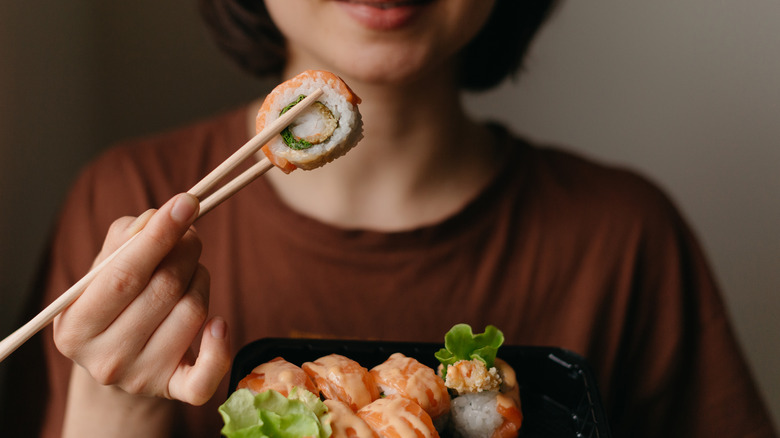11 Red Flags To Look Out For In Sushi Restaurants
Whether you frequent sushi restaurants or have only experienced them in a Harry Styles music video, they are a truly unique culinary destination that seafood fans adore. Not all sushi restaurants are created equal, however, and when it comes to consuming raw fish, it is absolutely vital that you dine in a clean establishment that serves high-quality ingredients.
Sushi can be quite a luxurious product, with some restaurants charging an arm and a leg for the finest seafood you will ever have. But it is just as easy to find affordable sushi, so it is to your advantage to do some research ahead of time. There are plenty of red flags to be on the lookout for, from how the restaurant itself is presented to warning signs from the food itself.
The next time you are craving sushi and decide to head out for dinner, keep these red flags in mind to avoid an unpleasant meal that you'll immediately regret and will definitely not forget.
1. The restaurant is never busy
Some red flags are universal no matter what kind of restaurant you are visiting. Whether it serves sushi, barbecue, or Italian cuisine, if you see an empty parking lot on a Saturday night, that is the first indicator that something is fishy.
There are some exceptions, like if the restaurant is brand new and word has not gotten around yet, but in general, you should take note of an empty parking lot when you're choosing where to eat. This is especially true if you pull into a busy strip mall or plaza where there are other businesses, and the restaurant you walk into is empty in comparison (via The Delite).
It is always worth it to track down the restaurant on review sites like Yelp to see if there are glaringly obvious reasons why it isn't popular. Perhaps you are simply visiting during an off-peak time.
2. The restaurant smells like fish
Seafood is a food group with a distinct smell that we all know and are not necessarily eager to regularly experience. However, that fishy odor we despise is not the norm, and if you notice it when walking into a sushi restaurant, then you are better off heading somewhere else. The truth is, fresh seafood should have no odor whatsoever. An off-putting fishy scent only creeps in once raw fish has been sitting out for too long or is being improperly stored.
One Redditor agrees and notes that you should not smell any fish when entering a sushi restaurant. If it smells more like the ocean than a dining establishment, you are probably going to be served fish that has been sitting out for far too long. A response on Quora also points out that the smell of strong cleaning products such as bleach may be a bad sign, as the restaurant could be overcompensating by trying to mask other odors.
3. The display case is not properly maintained
Many sushi restaurants have a glass display case featuring the fish included on the menu. You can actually tell a lot about the cleanliness of the establishment by taking a close look at the display case. If you notice it is not especially clean, that could be a red flag that both the restaurant and kitchen are not properly cared for. Like any other restaurant, you should expect to find an environment that is clean and well-presented, no matter how old the place may be.
In addition to cleanliness, you will want to make sure the display case is being kept at the right temperature. Fish that is stored in an environment that is too warm will not stay nearly as fresh for as long. One chef shared on Reddit that the display cases are kept anywhere between 32 or 40 degrees Fahrenheit, or approximately the same temperature as a standard refrigerator. Temperatures that stray too far below or above that range could spell disaster for your meal if you choose to dine there.
4. You cannot spot fresh fish in the display case
As you wait for your table to be ready, you might peruse through the glass display case to see what kinds of fish are featured on the menu. It will hint at the various roll options, and you may be able to decide what you want to order simply by looking at the fish.
However, to avoid any nasty surprises, you will want to examine whether the fish appears to be fresh. Fish that has been sitting out for too long or at a less-than-ideal temperature can go bad pretty quickly. When eating sushi, you should only look to eat the freshest ingredients possible to avoid any possible food-borne illness from the raw fish.
It's worth knowing that if the tuna in the display case is a bright red color, it has likely been treated with carbon monoxide to prevent a color change from oxidation (via The New York Times). The process is considered safe by the U.S. Food & Drug Administration (FDA), but this means that the fish won't change color the longer it sits out. True fresh tuna is a dark, almost maroon-looking color.
Another tip to keep in mind is to be wary of the day of the week you decide to visit a sushi restaurant. Since many fish markets are closed on Sundays, if you dine at a sushi restaurant that evening, you are likely eating fish that was delivered at least one day prior.
5. You cannot see the sushi being made
Preparing sushi is a skill and a craft that takes a long time to master. While there are sushi-making kits out on the market for you to prepare your own rolls at home, true sushi expertise is akin to any other art form. That is why many of the finest sushi restaurants showcase these artisans at work, preparing rolls in front of customers as the orders come in.
Now, it is not necessarily all doom and gloom if you walk in and you do not see a chef making fresh sushi right before your eyes. But it may be an indication that the sushi is made hours beforehand and sits in refrigerated storage until it is ordered. Pre-made sushi is safe to eat, but it may not have been made to the same standards, and you may just have to inspect it more carefully once it is served (via Secrets of Sushi).
Keep in mind that pre-made and pre-assembled sushi is not necessarily bad, but it could indicate that the restaurant receives mislabeled fish or pre-cut filets (via Thrillist). If you do not see the sushi rolls being freshly prepared as you walk in, simply take note and be ready to talk to your server about where they source their fish.
6. Staff does not know where the fish comes from
One of the bigger red flags to spot when dining at a sushi restaurant is whether or not the staff can tell you where they source the fish. When dealing with an ingredient as delicate as raw fish, its origin is critical. Now, the fish does not need to come from the most luxurious fish farm on the globe. In fact, the bigger issue here is likely not where it comes from, but if the staff has any clue.
The bad news is that fine-dining establishments aside, some of the fish you are eating is likely imitation meat, as journalist and author Larry Olmsted tells Thrillist. This is partly due to the fact that despite being a widely-used term, there are no exact guidelines established to define fish as being "sushi grade" (via WebstaurantStore). Other ambiguous terms that could mean a variety of things are also less than ideal. For example, one Redditor explains that white tuna is usually albacore, though some restaurants falsely label similar fish as white tuna.
It is always worth finding out where a restaurant gets its fish from, whether it is wild-caught or farm-raised, as well as whether it has been frozen and for how long.
7. Staff can't tell you when the fish gets delivered
Timing is crucial when running a sushi restaurant. Ideally, the establishment is serving you the freshest fish possible, but in reality, the odds are high that the sushi you are eating was not delivered to the restaurant that morning. Even if it was, chances are it was not caught at sea the day prior. There is probably some freezing process involved along the way to keep the ingredients fresh, but at the end of the day, a sushi restaurant should be able to tell you when the fish gets delivered. If the staff doesn't know or is not willing to answer that question, consider it a red flag.
While some people refuse to eat at a sushi restaurant that is not located close to the coast, others argue that it is perfectly fine thanks to the fact that food transportation has come a long way in recent years. Kobe Jones points out that most sushi restaurants receive their fish on ice, and that it is extremely rare to have sushi that came off a fishing boat that morning.
That being said, your fish should still be fresh. A good follow-up question is to see how recently the fish was thawed. There are specific FDA guidelines for thawing raw frozen fish that are worth knowing for your investigation.
8. The sushi comes with a lot of unnecessary ingredients
At its best, sushi should be made with very few ingredients of the freshest quality. All you should need as an accompaniment is some soy sauce, wasabi, or ginger. When you look through the menu at your local sushi restaurant and only see rolls drizzled in heavy sauces or containing fillings like cream cheese, odds are high that the restaurant is trying to compensate for the fact that its core ingredients are not up to par.
If all you taste when you bite into a sushi roll is the sauce that is served alongside, then you are probably being served poor-quality fish. This is a big red flag that suggests the restaurant does not have good ingredients; you may want to look for a new local spot to grab sushi.
Rolls with cream cheese or spicy mayonnaise are other red flags to be on the lookout for. It may seem like a unique menu item, but in reality, the chefs are just masking the ingredients that really matter. Depending on the unusual ingredients packed into a roll, the sushi you're eating may not be sushi at all based on authentic recipes.
9. The menu prices are too good to be true
Simply put, good sushi is going to cost you more money. Some of the ingredients, particularly fish that is not readily available, can come at a steep price for restaurants. In addition, it takes a lot of skill to hand-craft artisanal sushi rolls, which results in a higher monetary value. That can all add up to an expensive night out when you want to have high-quality sushi for dinner. If a sushi restaurant boasts low prices that are too good to be true, that is probably the case.
There are definitely restaurants that serve high-quality, affordable sushi, but it's best to be cautious at dining establishments that sell sushi cheap enough for you to tell your friends about your awesome bargain meal. You are better off saving your pennies to eat at a higher-end sushi restaurant less frequently than regularly acquiring cheap rolls, according to Larry Olmsted (via Thrillist). Essentially, you do not know what you are getting with cheap sushi, but you can probably bet it's either fake, mislabeled, or has traveled halfway across the globe.
10. They only have the basics on their menu
There is a fair argument to be made that the best sushi restaurants can survive off of the basics alone, but if all you see on the menu are tuna and salmon, then you may be dining at a restaurant that does not have a highly-skilled sushi chef on staff. While most diners can identify tuna and salmon, that makes for two very safe options when ordering at a sushi restaurant. In order to appeal to the masses, many restaurants may limit their options to simple fish like those, when there is in fact an entire world of underrated sushi rolls that you may enjoy more.
A menu that is filled with standard options like salmon and tuna may also be an indicator that the restaurant's ingredients are unsustainably sourced since they are so easy to acquire. If the most unique item on the menu is spicy mayonnaise, the restaurant is probably not the real deal, as one Redditor points out regarding the overrated ingredient. This commenter recommends people be on the lookout for Temaki rolls, especially if there is a chef on staff who knows how to properly make them.
11. The fish is mushy
The texture of your food can say a lot about its freshness and preparation, and ultimately if you should even take a bite. When your sushi arrives, the first thing you should do (especially if you have already encountered several red flags at the restaurant) is to press down on the fish. The texture should have some bounce to it, indicating freshness. However, if you find that the fish is on the mushier side, that is a big warning sign that you are not being served high-quality ingredients.
According to the FDA, fresh fish should be slightly firm with a spring to it when you apply pressure. Cleveland Clinic concurs that a firm consistency and no odor are elements to look for when being served raw fish. If you detect a spongy texture, you are best not to consume that fish. There is a whole slew of risks to consuming raw fish according to Healthline, so it is to your benefit to make sure the product you are being served is safe to eat.
